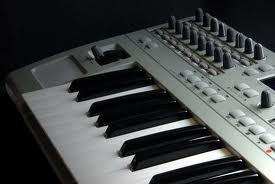Connecting a MIDI
Keyboard Controller to a Computer

How to Install a
MIDI Keyboard
A musical
instrument digital interface (MIDI) keyboard uses digital
technology to send audio signals to another device for
processing the sound, playback and recording. Resembling an
electric piano, the MIDI keyboard can connect to a PC for
altering the sound of the instrument, blending it with other
audio sources and recording a final mix on the hard drive.
Many computers are equipped with a MIDI port for a direct
connection, or you can use a USB port on the PC with an
adapter cable to connect it.
Connecting a MIDI
keyboard to a PC will enable you to use a range of software
and interactive features with the device. Connection is the
first step before using the keyboard. It can be accomplished
in a variety of ways depending on your available ports,
software and type of keyboard.
Steps
1
Open the
computer's CD-ROM drive tray to load the software CD that
comes with the MIDI keyboard. Close the tray and wait a moment
for the disc to start automatically.
2
Click the buttons
as instructed on the computer monitor to install the MIDI
software, and then restart the computer.
3
Locate the MIDI
port on your keyboard. Most keyboards will have a MIDI in and
MIDI out port located near the back for connection to the PC.
The ports are circular and usually labeled clearly. If the
keyboard does not have a MIDI port, it may have a USB port.
Locate one of these ports for connection.
4
Determine the
type of port you'll be using to connect the keyboard to the
PC. Connecting directly to the soundcard on your computer
requires a 15-pin gameport found on the back of your PC.
Connect to your PC through a USB port if you have a MIDI to
USB connector or a USB port on your keyboard. Some computers
come with a pre-installed MIDI port.
5
To connect the
keyboard to the soundcard, connect the 15-pin male connector
to the 15-pin port on the back of your PC. Connect the 5-pin
"MIDI OUT" connector to the "MIDI IN" port on your keyboard.
Connect the 5-pin "MIDI IN" connector to the "MIDI OUT" port
on your keyboard.
6
To connect the
keyboard using a USB connection or MIDI to MIDI connection,
connect one end of the USB or MIDI cord to the appropriate
port on your PC. Connect the other end to the corresponding
port on your keyboard.
7
Configure your
keyboard depending on your particular software. If connecting
through a USB port, you will generally not need to configure
as your system will automatically detect the new device. If
your PC doesn't detect the keyboard or nothing happens when
the connector is appropriately attached, you will need to
configure. Use the software that comes with your keyboard to
install or download drivers from the manufacturer website and
follow the installation instructions.
Open your audio
workstation software. Make sure that your MIDI keyboard is
configured to properly interface with the software. This can
be done within your software's Options, Preferences or Devices
menu. For example, in Cubase, your keyboard should be listed
in the Device setup menu. Select it as the desired MIDI input
device.
8
Open or begin a
project that utilizes the desired VST instrument.
9
Open the VST
instrument's window by selecting the instrument in your
workstation. Often, the window can be enlarged by
double-clicking on it where it appears in a specific audio
track.
10
Open the VST
instrument's drop-down menu. Each VST instrument is slightly
different, but there should be an option that references
"Control" or "Controlling" (sometimes this option is
straightforwardly labeled "MIDI"). Select this option, and
assign the desired MIDI channels and controls to the desired
parameters. Typically, MIDI devices are prepared to send and
receive messages on 16 channels, each of which has a number of
controls corresponding to the keys and knobs on the device.
Your VST instrument parameters will often correspond to these
keys automatically, though you can change them within this
menu. You should then be able to control your VST instrument
using your USB keyboard.
Note: You can
purchase a MIDI to USB connector cable if your keyboard does
not have a USB port and your computer does not have a MIDI
port. These connectors can be expensive but make for easy
connection with little hassle. The other alternative is to
have a MIDI port installed in your computer.

MIDI is a
trademark of MIDI Manufacturers Association Incorporated.
About MIDI -
Making Music with MIDI
- MIDI Controllers -
MIDI Products -
MIDI Glossary -
MIDI Polyphonic
Expression (MPE)

